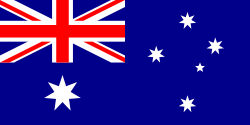Pama-Nyungan languages
| Pama-Nyungan | |
|---|---|
| Geographic distribution: |
Victoria River, Northern Territory |
| Genetic classification: |
Macro-Pama-Nyungan Greater Pama-Nyungan Pama-Nyungan |
| Subdivisions: |
Yolŋu Matha
Pama-Maric
Nyawaygic
Waka-Kabic
Durubalic
Yuin-Kuric
Wiradhuric
Baagandji
Yotayotic
Kulinic
Ngarinyeric-Yithayithic
Karnic
Pitta-Pitta
Arabana
Yardli
Wagaya-Warluwaric
Kalkatungic
Arandic
Southwest (Nyungic)
Muk Thang
Dhuduroa |
The Pama-Nyungan languages are the most widespread family of Indigenous Australian languages.
The Pama-Nyungan family was identified and named by Kenneth Hale, in his work on the classification of Native Australian languages. Hale realised that of the Aboriginal Australian languages, one relatively closely-interrelated family had spread and proliferated over most of the continent, while approximately a dozen other families were concentrated along the North coast. The Pama-Nyungan family accounts for most of the geographic spread, most of the Aboriginal population, and the greatest number of languages.
The name "Pama-Nyungan" was derived from the names of two widely-separated groups, the Pama languages from the Northeast, and the Nyungan languages from the Southwest. The terms pama and nyunga are expressions meaning "man" in the languages from their respective regions.
The other language families indigenous to the continent of Australia are occasionally referred to, by exclusion, as Non-Pama-Nyungan languages, though this is not a proper taxonomic term.
Although counting languages is not, in general, a well-defined operation, there are on the order of hundreds of Pama-Nyungan languages. Most of the Pama-Nyungan languages are spoken by small ethnic groups, with thousands of speakers or fewer. Many are considered endangered languages, and many have recently become extinct.
Classification and Languages
According to Nicholas Evans at the Australian National University, the closest relative of Pama-Nyungan is the Garawa isolate, followed by the small Tankic family. He then proposes a more distant relationship with the Gunwinyguan languages in a macro-family he calls Macro-Pama-Nyungan.
Pama-Nyungan proper includes approximately 175 languages in 14 extant and numerous extinct branches.
- Yuulngu or Yolŋu Matha: Djinang, Dhangu, Dhuwal, Djinba, Ritharngu, Dhay'yi, Yan-nhangu
- Kala Lagaw Ya (Mabuiag)
- Northeast (Pama-Maric)
- (See article for membership)
- Nyawaygic: Nyawaygi, Wulguru
- Waka-Kabic: Darambal, Bayali, Gureng Gureng, Gabi, Wuliwuli, Waga, Barunggam, Muringam
- Durubalic: Turrubal, Gowar
- Gumbaynggiric: Gumbaynggir, Yaygir
- Yuin-Kuric: Ugarapul, Yugambeh, Nganyaywana, Dyangadi, Worimi, Awabakal, Gudungura, Ngarigu, Thawa, Dyirringany, Dhurga, Dharawal, Darkinyung, Dharuk
- Wiradhuric: Gamilaraay, Ngiyambaa, Wiradhuri
- Baagandji: Bandjigali, Baagdandji
- Yotayotic: Yotayota, Yabula-Yabula
- Kulinic: Wemba Wemba, Nari Nari, Wathawurung, Kolakngat, Wuywurung, Bungandidj, Kuurn Kopan Noot, Chaap Wuurong
- Ngarinyeric-Yithayithic: Ngarinyeri, Ngayawung, Yuyu, Keramin, Yitha-Yitha
- Karnic (reduced): Ngamini, Yandruwandha, Diyari, Pirlatapa, Yarluyandi, Garuwali, Midhaga, ? Lhanima
- Pitta-Pitta
- Arabana
- Yardli: Malyangaba, Yardliwarra
- Wagaya-Warluwaric: Wagaya, Yindjilandji, Warluwara
- Kalkatungic: Kalkatungu, Yalarnnga
- Arandic: Kaytetye, Alyawarre, Arrernte, Lower Arrernte, Andegerebinha, Anmatyerre
- Southwest
- (See article for membership)
- Muk Thang
- Dhuduroa
- Muruwari
- Warumungu
- Flinders Island
- Barrow Point
- Bandjalang
- Pallangahmiddang
See also
- Gunwinyguan languages
- Macro-Pama-Nyungan languages
- Southwest Pama-Nyungan languages
- Proto-Pama-Nyungan language
References
- McConvell, Patrick and Nicholas Evans. (eds.) 1997. Archaeology and Linguistics: Global Perspectives on Ancient Australia. Melbourne: Oxford University Press
- Evans, Nicholas. (eds.) 2003. The Non-Pama-Nyungan Languages of Northern Australia. Comparative studies of the continent's most linguistically complex region. Canberra: Pacific Linguistics
|
||||||||||||||||
